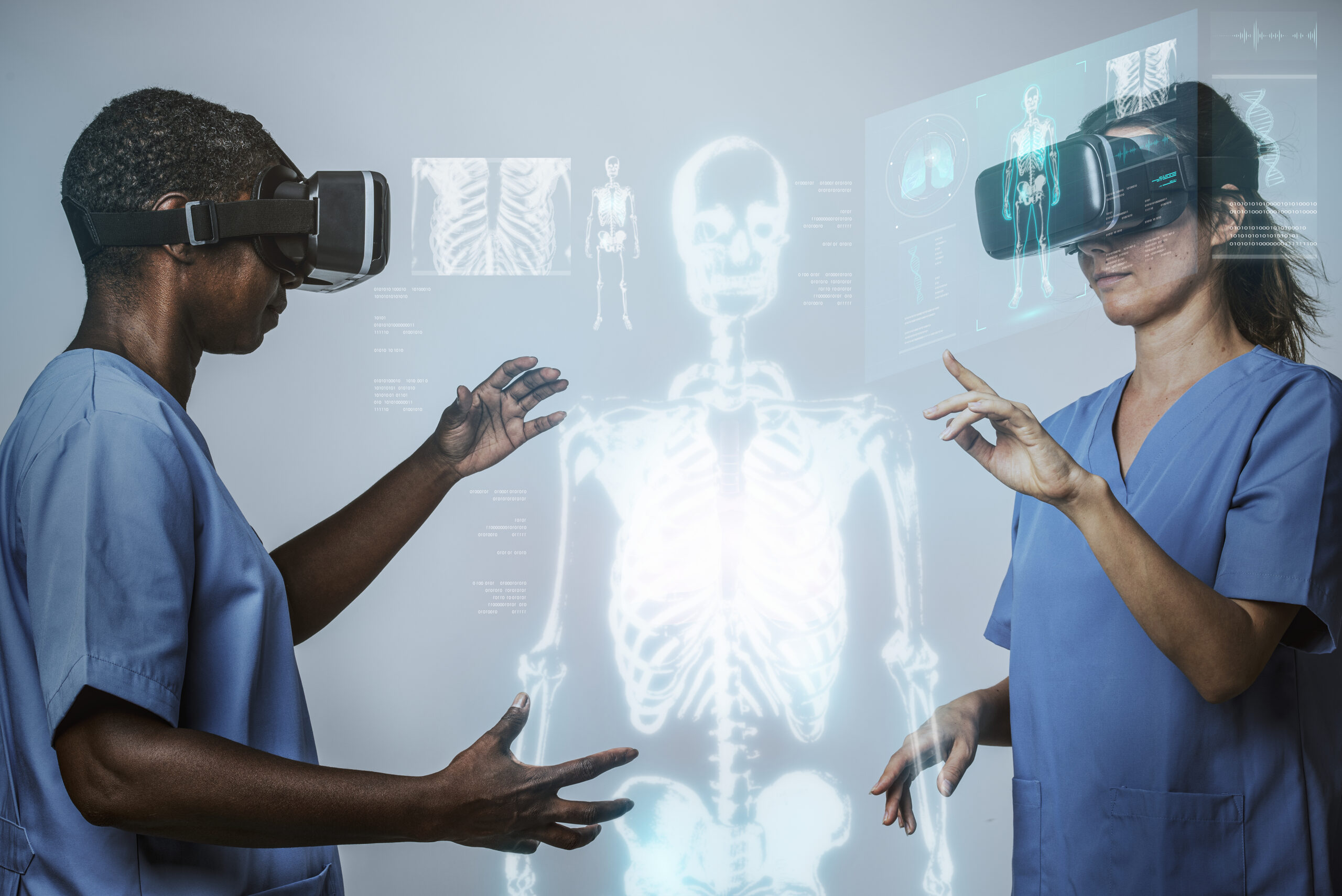Generative AI in Healthcare_ Engineering Innovative Solutions for Diagnosis and Treatment

Generative Artificial Intelligence (AI) is revolutionizing healthcare by offering innovative solutions for diagnosis and treatment. In this article, we’ll delve into the concept of generative AI in healthcare, exploring its definition, significance, and how it operates in the realm of diagnosis and treatment.
Generative AI uses algorithms and models to create new data based on existing datasets. In healthcare, this technology utilizes machine learning techniques to generate medical images, patient data, and even drug compounds. Unlike traditional AI, which relies on labeled data for classification tasks, generative AI can create synthetic data that mimics real-world examples, enabling healthcare professionals to explore scenarios and solutions that may not be readily available in clinical settings.
The application of generative AI holds immense promise for healthcare. By leveraging vast amounts of medical data, this technology can improve diagnostic accuracy, personalize treatment plans, and even discover novel therapies. Moreover, generative AI has the potential to address challenges such as data scarcity, privacy concerns, and the need for diverse datasets by generating synthetic data that preserves key characteristics while ensuring patient confidentiality.
Generative AI operates through various algorithms, including Generative Adversarial Networks (GANs), Variational Autoencoders (VAEs), and Transformer models. These algorithms learn from large datasets to generate new data points by capturing underlying patterns and relationships. In healthcare, generative AI can develop medical images, such as MRI scans and X-rays, predict patient outcomes, and even design personalized treatment plans based on individual patient data.
Going deeper into the role of generative AI in healthcare, we’ll explore its applications across different medical domains, its impact on patient care, and the challenges and opportunities it presents for the future of medicine.
Diagnosis Using Generative AI

Generative AI has emerged as a powerful tool in medical diagnosis, particularly in medical imaging, where it offers significant advancements in accuracy and efficiency. This section will explore how generative AI revolutionizes the diagnostic process by enhancing medical imaging and addressing data limitations.
Generative AI is increasingly being integrated into medical imaging workflows to improve the interpretation of radiological scans such as MRI, CT, and X-ray images. By harnessing the power of deep learning algorithms, generative AI can assist radiologists in detecting subtle abnormalities and making accurate diagnoses.
One of the critical benefits of generative AI in medical imaging is its ability to enhance diagnostic accuracy. By analyzing vast datasets of annotated medical images, generative AI algorithms can learn to identify patterns associated with various pathologies, leading to more precise detection of anomalies such as tumors, fractures, and other abnormalities.
Generative AI has demonstrated remarkable success in numerous medical imaging tasks. For instance, in detecting tumors, generative AI algorithms can highlight regions of interest within MRI or CT scans, aiding radiologists in the early detection and characterization of cancerous lesions. Similarly, in the case of fractures, generative AI can assist in identifying subtle fractures or bone abnormalities that may be challenging to detect with the naked eye.
One of the most significant advantages of generative AI is its ability to synthesize realistic medical data, thereby augmenting existing datasets and addressing the challenge of limited real-world data. By generating synthetic images that closely resemble actual patient scans, generative AI enables more robust training of diagnostic models, leading to improved performance and generalization.
Generative AI techniques such as Generative Adversarial Networks (GANs) and Variational Autoencoders (VAEs) are crucial in generating synthetic medical images for training machine learning models. These models can generate diverse examples of medical conditions, allowing algorithms to learn from a broader spectrum of data and adapt to variations in patient anatomy and imaging protocols.
In many medical imaging tasks, acquiring labeled data for training AI models can be challenging due to privacy concerns, data scarcity, and the need for expert annotations. Generative AI offers a solution to this problem by generating synthetic data that mimics real-world examples, enabling more robust and reliable training of diagnostic algorithms.
By harnessing the power of generative AI in medical diagnosis, healthcare providers can improve patient outcomes, accelerate the diagnostic process, and unlock new insights into complex diseases. As the field continues to evolve, we can expect further medical imaging and diagnosis innovations driven by generative AI’s transformative capabilities.
Drug Discovery and Development

Generative AI is revolutionizing drug discovery and development, offering innovative solutions to accelerate the identification of novel therapeutics and streamline the drug development process. This section will explore how generative AI transforms drug discovery by generating novel molecular structures, optimizing lead compounds, and repurposing existing drugs for new therapeutic applications.
Generative AI expedites drug discovery by rapidly generating vast libraries of molecular structures and predicting their potential biological activities. By harnessing machine learning algorithms, researchers can explore diverse chemical spaces more efficiently, accelerating the identification of promising drug candidates for further development.
One of the critical capabilities of generative AI in drug discovery is its ability to generate novel molecular structures with desired properties, such as potency, selectivity, and bioavailability. By leveraging deep learning techniques, generative AI algorithms can design molecules that target specific biological targets or pathways, facilitating the discovery of new therapeutics for various diseases.
Generative AI streamlines lead optimization and preclinical testing by prioritizing promising drug candidates and guiding experimental design. Generative AI helps researchers focus resources on the best candidates by predicting candidate compounds’ pharmacokinetic and pharmacodynamic properties, reducing the time and cost associated with traditional trial-and-error approaches.
Generative AI enables the repurposing of existing drugs for new therapeutic uses by predicting their interactions with different biological targets or pathways. By analyzing large-scale drug databases and molecular structures, generative AI algorithms can identify potential drug candidates for repurposing, accelerating the discovery of new treatments for existing diseases.
Generative AI facilitates the identification of new therapeutic uses for known compounds by predicting their biological activities and exploring their potential applications across different disease areas. Generative AI can uncover unexpected connections between drugs and diseases by leveraging machine learning models trained on diverse datasets, leading to novel therapeutic insights.
Overall, generative AI shortens timelines and reduces costs in drug development by expediting the discovery and optimization of drug candidates, facilitating the repurposing of existing drugs, and accelerating the translation of preclinical findings into clinical trials. By leveraging the predictive power of AI, pharmaceutical companies can bring new therapies to market faster and more efficiently, ultimately benefiting patients and healthcare systems worldwide.
Future Directions and Challenges

As generative AI continues to evolve, its potential in healthcare is poised to drive transformative advancements in diagnosis, treatment, and drug discovery. However, along with these opportunities come significant challenges that must be addressed to realize the full potential of this technology. In this section, we’ll explore potential future directions for generative AI in healthcare and the key challenges that must be overcome.
The future of generative AI in healthcare holds promise for numerous advancements, including:
- Integration of Multimodal Data Sources: Generative AI can leverage diverse data types, including genomic, clinical, and imaging data, to provide a comprehensive understanding of patient health and disease.
- Real-Time Adaptive Systems: AI-driven systems can dynamically adjust treatment plans in real time based on patient responses and evolving clinical conditions. Personalized Medicine: Generative AI enables the customization of treatments and interventions based on individual patient characteristics, leading to improved outcomes and patient satisfaction.
- Drug Discovery Innovations: AI-powered drug discovery platforms can accelerate the identification of novel therapeutics and streamline drug development.
Addressing Challenges and Limitations
Despite its potential, generative AI in healthcare faces several challenges that must be addressed:
- Interpretable AI Models: Ensuring the interpretability and transparency of AI models is essential for gaining trust and acceptance from healthcare providers and patients.
- Data Quality and Privacy: Generative AI relies on large datasets for training, raising concerns about data quality, bias, and patient privacy.
- Technical Barriers: Overcoming technical challenges such as computational constraints, model scalability, and robustness is crucial for deploying generative AI solutions in real-world healthcare settings.
Integration of Multimodal Data Sources
Generative AI can integrate and analyze multimodal data sources, including genomic, clinical, and imaging data, to provide a holistic view of patient health and disease. By combining diverse data types, AI-driven systems can generate more accurate predictions and personalized recommendations, improving diagnostic accuracy and treatment outcomes.
AI-driven systems can dynamically adjust treatment plans based on patient responses and evolving clinical conditions. By continuously monitoring patient data and adapting treatment strategies accordingly, generative AI enables personalized and proactive healthcare delivery, improving patient outcomes and reducing healthcare costs.
To realize the full potential of generative AI in healthcare, several challenges must be addressed:
- Interpretable AI Models: Ensuring the interpretability and transparency of AI models is essential for gaining trust and acceptance from healthcare providers and patients. Explainable AI techniques can help make AI-driven decisions more transparent and understandable, facilitating their adoption in clinical practice.
- Data Quality and Privacy: Generative AI relies on large datasets for training, raising concerns about data quality, bias, and patient privacy. Implementing robust data governance frameworks and ensuring compliance with regulatory requirements is essential for safeguarding patient privacy and data integrity.
- Technical Barriers: Overcoming technical challenges such as computational constraints, model scalability, and robustness is crucial for deploying generative AI solutions in real-world healthcare settings. Advancements in hardware technology, algorithmic innovation, and model optimization techniques are needed to address these barriers and enable the widespread adoption of generative AI in healthcare.
Conclusion
Generative AI holds immense potential to revolutionize healthcare by transforming diagnosis, treatment, and drug discovery. Throughout this article, we’ve explored how generative AI reshapes the healthcare landscape by enabling personalized medicine, accelerating drug discovery, and improving clinical decision-making.
And the potential of generative AI to transform healthcare is vast and far-reaching. By embracing innovation, fostering collaboration, and upholding ethical principles, we can harness the transformative power of generative AI to shape a brighter future for medicine and patient care. Together, let’s continue to push the boundaries of possibility and ensure that generative AI fulfills its promise of revolutionizing healthcare for the benefit of all.

